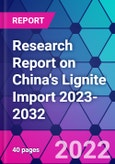In 2021, China's lignite imports reached 118.91 million tons, up 20.19% year-on-year, with an import value of US$9.024 billion, up 132.89% year-on-year. From January to October 2022, China imported 102.95 million tons of lignite, up 6.32% year-on-year, with an import value of US$9.797 billion, up 53.91% year-on-year.
The publisher's analysis, from 2018-2022, the average price of China's lignite imports generally shows a decreasing trend followed by an increasing trend. From 2018-2020, the average price of China's lignite imports continues to fall, from US$52.45 per ton in 2018 to US$39.16 per ton in 2020. From 2020, the average price of China's lignite imports increases continuously. In 2021, the average price of China's lignite imports was US$75.89 per ton, up 93.77% y-o-y. From January to October 2022, the average price of China's lignite imports was US$95.16 per ton, up 44.76% y-o-y.
China's sources of lignite imports are relatively concentrated. In 2021, China imports lignite from 8 countries. According to the publisher's analysis, Indonesia, the Philippines and the Russian Federation are China's main sources of lignite imports by import volume. Among them, Indonesia is the largest lignite importer in China. In 2021, China imported 107,727,100 tons of Indonesian lignite, accounting for 90.60% of the total lignite imports in that year, and the import value of US$8.219 billion, accounting for 91.08% of the total import value.
The publisher expects China's lignite imports to continue to rise in 2023-2032.
Topics covered:
- China's Lignite Import Status and Major Sources in 2018-2022
- What is the Impact of COVID-19 on China's Lignite Import?
- Which Companies are the Major Players in China's Lignite Import Market and What are their Competitive Benchmarks?
- Key Drivers and Market Opportunities in China's Lignite Import
- What are the Key Drivers, Challenges, and Opportunities for China's Lignite Import during 2023-2032?
- What is the Expected Revenue of China's Lignite Import during 2023-2032?
- What are the Strategies Adopted by the Key Players in the Market to Increase Their Market Share in the Industry?
- What are the Competitive Advantages of the Major Players in China's Lignite Import Market?
- Which Segment of China's Lignite Import is Expected to Dominate the Market in 2032?
- What are the Major Adverse Factors Facing China's Lignite Import?
Table of Contents
Methodology
Background research defines the range of products and industries, which proposes the key points of the research. Proper classification will help clients understand the industry and products in the report.
Secondhand material research is a necessary way to push the project into fast progress. The analyst always chooses the data source carefully. Most secondhand data they quote is sourced from an authority in a specific industry or public data source from governments, industrial associations, etc. For some new or niche fields, they also "double-check" data sources and logics before they show them to clients.
Primary research is the key to solve questions, which largely influence the research outputs. The analyst may use methods like mathematics, logical reasoning, scenario thinking, to confirm key data and make the data credible.
The data model is an important analysis method. Calculating through data models with different factors weights can guarantee the outputs objective.
The analyst optimizes the following methods and steps in executing research projects and also forms many special information gathering and processing methods.
1. Analyze the life cycle of the industry to understand the development phase and space.
2. Grasp the key indexes evaluating the market to position clients in the market and formulate development plans
3. Economic, political, social and cultural factors
4. Competitors like a mirror that reflects the overall market and also market differences.
5. Inside and outside the industry, upstream and downstream of the industry chain, show inner competitions
6. Proper estimation of the future is good guidance for strategic planning.

LOADING...








